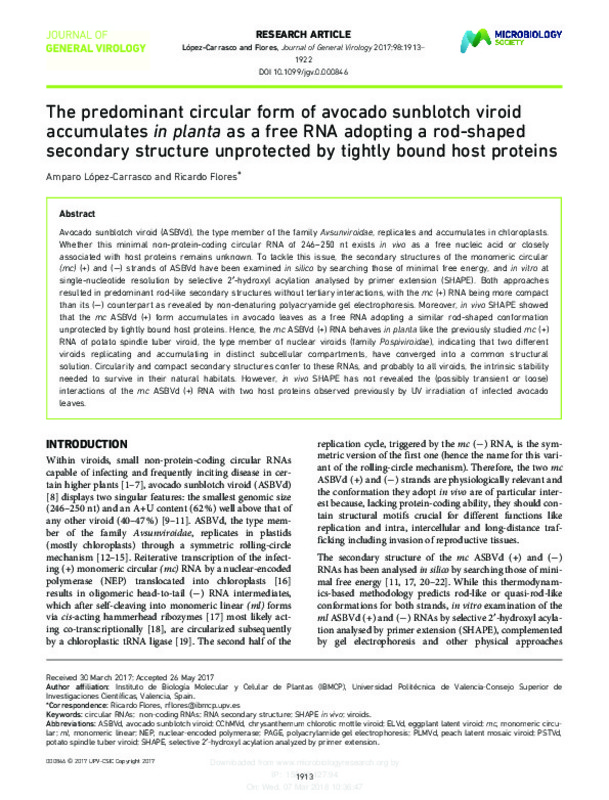JavaScript is disabled for your browser. Some features of this site may not work without it.
Buscar en RiuNet
Listar
Mi cuenta
Estadísticas
Ayuda RiuNet
Admin. UPV
The predominant circular form of avocado sunblotch viroid accumulates in planta as a free RNA adopting a rod-shaped secondary structure unprotected by tightly bound host proteins
Mostrar el registro sencillo del ítem
Ficheros en el ítem
| dc.contributor.author | López-Carrasco, María Amparo
|
es_ES |
| dc.contributor.author | Flores Pedauye, Ricardo
|
es_ES |
| dc.date.accessioned | 2018-05-25T04:27:58Z | |
| dc.date.available | 2018-05-25T04:27:58Z | |
| dc.date.issued | 2017 | es_ES |
| dc.identifier.issn | 0022-1317 | es_ES |
| dc.identifier.uri | http://hdl.handle.net/10251/102633 | |
| dc.description.abstract | [EN] Avocado sunblotch viroid (ASBVd), the type member of the family Avsunviroidae, replicates and accumulates in chloroplasts. Whether this minimal non-protein-coding circular RNA of 246-250 nt exists in vivo as a free nucleic acid or closely associated with host proteins remains unknown. To tackle this issue, the secondary structures of the monomeric circular (mc) (+) and (-) strands of ASBVd have been examined in silico by searching those of minimal free energy, and in vitro at single-nucleotide resolution by selective 2'-hydroxyl acylation analysed by primer extension (SHAPE). Both approaches resulted in predominant rod-like secondary structures without tertiary interactions, with the mc (+) RNA being more compact than its (-) counterpart as revealed by non-denaturing polyacryamide gel electrophoresis. Moreover, in vivo SHAPE showed that the mc ASBVd (+) form accumulates in avocado leaves as a free RNA adopting a similar rod-shaped conformation unprotected by tightly bound host proteins. Hence, the mc ASBVd (+) RNA behaves in planta like the previously studied mc (+) RNA of potato spindle tuber viroid, the type member of nuclear viroids (family Pospiviroidae), indicating that two different viroids replicating and accumulating in distinct subcellular compartments, have converged into a common structural solution. Circularity and compact secondary structures confer to these RNAs, and probably to all viroids, the intrinsic stability needed to survive in their natural habitats. However, in vivo SHAPE has not revealed the (possibly transient or loose) interactions of the mc ASBVd (+) RNA with two host proteins observed previously by UV irradiation of infected avocado leaves. | es_ES |
| dc.description.sponsorship | This work was supported by grant BFU2014-56812-P (to R. F.) from the Ministerio de Economia y Competitividad of Spain. A. L. C. was the recipient of a predoctoral fellowship from the same organization. | es_ES |
| dc.language | Inglés | es_ES |
| dc.publisher | Microbiology Society | es_ES |
| dc.relation.ispartof | Journal of General Virology | es_ES |
| dc.rights | Reserva de todos los derechos | es_ES |
| dc.subject | Circular RNAs | es_ES |
| dc.subject | Non-coding RNAs | es_ES |
| dc.subject | RNA secondary structure | es_ES |
| dc.subject | SHAPE in vivo | es_ES |
| dc.subject | Viroids | es_ES |
| dc.title | The predominant circular form of avocado sunblotch viroid accumulates in planta as a free RNA adopting a rod-shaped secondary structure unprotected by tightly bound host proteins | es_ES |
| dc.type | Artículo | es_ES |
| dc.identifier.doi | 10.1099/jgv.0.000846 | es_ES |
| dc.relation.projectID | info:eu-repo/grantAgreement/MINECO//BFU2014-56812-P/ES/VIROIDES, LOS PARASITOS EXTREMOS: EVOLUCION ESPACIO-TEMPORAL, PATOGENESIS MEDIADA POR SILENCIAMIENTO VIA RNA, Y DEGRADACION/ | es_ES |
| dc.rights.accessRights | Abierto | es_ES |
| dc.contributor.affiliation | Universitat Politècnica de València. Instituto Universitario Mixto de Biología Molecular y Celular de Plantas - Institut Universitari Mixt de Biologia Molecular i Cel·lular de Plantes | es_ES |
| dc.description.bibliographicCitation | López-Carrasco, MA.; Flores Pedauye, R. (2017). The predominant circular form of avocado sunblotch viroid accumulates in planta as a free RNA adopting a rod-shaped secondary structure unprotected by tightly bound host proteins. Journal of General Virology. 98(7):1913-1922. https://doi.org/10.1099/jgv.0.000846 | es_ES |
| dc.description.accrualMethod | S | es_ES |
| dc.relation.publisherversion | https://doi.org/10.1099/jgv.0.000846 | es_ES |
| dc.description.upvformatpinicio | 1913 | es_ES |
| dc.description.upvformatpfin | 1922 | es_ES |
| dc.type.version | info:eu-repo/semantics/publishedVersion | es_ES |
| dc.description.volume | 98 | es_ES |
| dc.description.issue | 7 | es_ES |
| dc.relation.pasarela | S\357594 | es_ES |
| dc.contributor.funder | Ministerio de Economía y Competitividad | es_ES |








